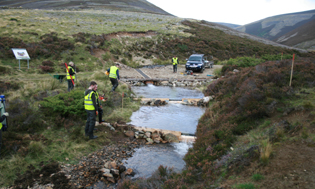 Salmon in the River Don are now benefiting from far easier access to an important tributary for spawning. This follows alterations to and the installation of a new pass at the Nochty vehicle ford on the Little Glen Burn, a tributary of the Water of Nochty in Glen Nochty Burn on Edinglassie Estate near Strathdon. The improvements should enable the river’s salmon to utilise to maximum extent over six km of productive spawning and juvenile habitat.
Salmon in the River Don are now benefiting from far easier access to an important tributary for spawning. This follows alterations to and the installation of a new pass at the Nochty vehicle ford on the Little Glen Burn, a tributary of the Water of Nochty in Glen Nochty Burn on Edinglassie Estate near Strathdon. The improvements should enable the river’s salmon to utilise to maximum extent over six km of productive spawning and juvenile habitat.
Tributaries in the upper part of the Don system’s catchment are believed to be vital spawning areas for spring salmon, the most fragile component of the Don’s stocks of migratory fish.
Jamie Urquhart, Biologist for the River Don Trust, explained: “The vehicle ford across the Little Glen Burn was clearly a significant obstacle for salmon to negotiate as they tried to migrate upstream. Having obtained the necessary consents from SEPA and of course the owners Dunecht Estates, the actual work to rectify this went smoothly and quickly, not least because we were ably assisted by the Bibby Offshore volunteer group and machinery from Frank Taylor Plant. We adopted the same approach as for the easing of the Ernan weir in 2012, creating a wooden channel for fish to ascend and descend through whilst retaining the function of the estate vehicle ford”.
Mr Urquhart continued: “In the next few weeks we look forward to observing salmon using the new channel at will and then spawning above. We are very grateful to John Riley for supplying all the necessary timber, to Bibby Offshore Ltd for the provision of the steel gangway grating and to Dunecht Estates for other materials”.
Stuart Young, Chief Executive of Dunecht Estates (Edinglassie is part of Dunecht Estates), commented: “Following the easing of the Ernan weir in 2012, we are pleased to have contributed to another River Don Trust project aimed at maximising the amount of the Don’s catchment that is easily available to the river’s salmon. This has to be one of the best ways of ensuring the Don’s future salmon runs”.
Easing access over obstacles to allow fish maximum opportunities to utilize as much riparian habitat as possible is a proven way of enhancing and increasing salmon populations.
